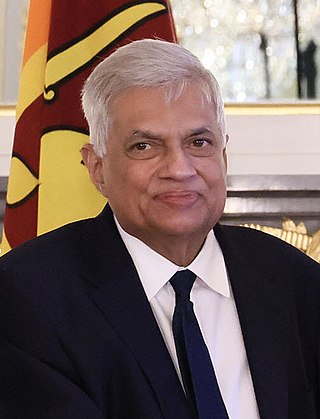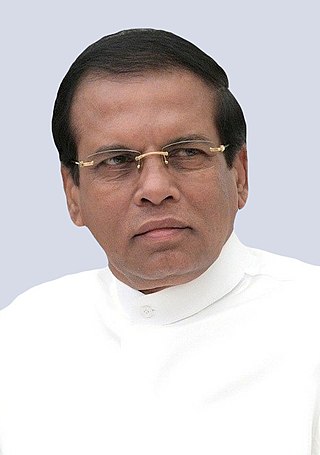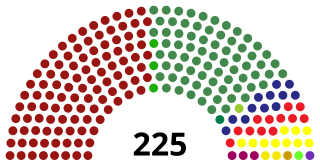
The president of Sri Lanka is the head of state and head of government of the Democratic Socialist Republic of Sri Lanka. The president is the chief executive of the union government and the commander-in-chief of the Sri Lanka Armed Forces.

Ranil Wickremesinghe is a Sri Lankan politician who is the 9th and current President of Sri Lanka. He also holds several ministerial positions, including the Minister of Finance, Minister of Defence, Minister of Technology and Minister of Women, Child Affairs and Social Empowerment.

The United National Party, often abbreviated as UNP, is a centre-right political party in Sri Lanka. The UNP has served as the country's ruling party, or as part of its governing coalition, for 38 of the country's 74 years of independence, including the periods 1947–1956, 1965–1970, 1977–1994, 2001–2004 and 2015–2019. The party also controlled the executive presidency from its formation in 1978 until 1994 and back in 2022.

Mahinda Rajapaksa is a Sri Lankan politician. He served as the President of Sri Lanka from 2005 to 2015; the Prime Minister of Sri Lanka from 2004 to 2005, 2018, and 2019 to 2022; the Leader of the Opposition from 2002 to 2004 and 2018 to 2019, and the Minister of Finance from 2005 to 2015 and 2019 to 2021. He has been a Member of Parliament (MP) for Kurunegala since 2015.

The United National Front (UNF) later the United National Front for Good Governance (UNFGG) was a political alliance in Sri Lanka led by the United National Party.

Maithripala Yapa Sirisena is a Sri Lankan politician who served as the seventh President of Sri Lanka from 9 January 2015 to 18 November 2019. Sirisena is Sri Lanka's first president from the North Central Province of the country and does not belong to the traditional Sri Lankan political elite. He is currently a member of parliament from Polonnaruwa.

Dissanayake Mudiyanselage Sumanaweera Banda Dissanayake, MP is a Sri Lankan politician. He is the former Cabinet Minister of Higher Education in President Mahinda Rajapakse's Government. He was the former general secretary of Sri Lanka Freedom Party and former national organiser of the United National Party. Dissanayake lost his cabinet position after Rajapaksha was defeated at the 2015 presidential election in Sri Lanka.

Vasudeva Nanayakkara is a Sri Lankan left-wing politician, Member of Parliament and presidential candidate in the 1982 and 1999 Sri Lankan presidential elections.

The Prime Minister of the Democratic Socialist Republic of Sri Lanka is the head and most senior member of parliament in the cabinet of ministers. It is the second-most powerful position in Sri Lanka's executive branch behind the president, who is the constitutional chief executive. The Cabinet is collectively held accountable to parliament for their policies and actions.
The Rajapaksa family is a Sri Lankan family that is prominent in politics. It was one of Sri Lanka's most powerful families during Mahinda Rajapaksa's presidency, when many members of the family occupied senior positions in the Sri Lankan state. As their political power grew, there were reports suggesting that the country was heading towards autocracy under their rule. Following the unexpected defeat of Mahinda Rajapaksa in the 2015 presidential election, they have been accused of authoritarianism, corruption, nepotism and bad governance. In the 2019 presidential election, Gotabaya Rajapaksa, the brother of Mahinda Rajapaksa, ran and won. The popularity of the Rajapaksa family collapsed after their actions caused the economic crisis that started in 2019, resulting in Sri Lanka defaulting on its debt for the first time in its post-independence history within just 30 months of coming to power. The extended Rajapaksa family is believed to have amassed a large amount of wealth and while the amount of and scale is unknown several members of the family have been revealed in international investigations such as the Pandora Papers to be using networks of shell companies and trusts to hide their wealth in offshore tax havens which has led to accusations of Rajapaksas turning Sri Lanka into a Kleptocracy
The Constitutional Council (CC) is a 10-member constitutional authority in Sri Lanka tasked with maintaining independent commissions and monitoring its affairs. The Constitutional Council is aimed at depoliticizing the public service.

The Sri Lanka People's Front, commonly known by its Sinhalese name Sri Lanka Podujana Peramuna (SLPP), is a political party in Sri Lanka. Previously a minor political party known as the Sri Lanka National Front (SLNF) and Our Sri Lanka Freedom Front (OSLFF), it was relaunched in 2016 as the SLPP and became the home for members of the United People's Freedom Alliance loyal to its former leader Mahinda Rajapaksa.

A constitutional crisis began in Sri Lanka when President Maithripala Sirisena appointed former president and member of parliament Mahinda Rajapaksa as Prime Minister on 26 October 2018 before formally dismissing the incumbent Ranil Wickremesinghe, resulting in two concurrent Prime Ministers. Wickremesinghe and the United National Party (UNP) viewed the appointment as illegal, and he refused to resign.

Parliamentary elections were held in Sri Lanka on 5 August 2020 to elect 225 members to Sri Lanka's 16th Parliament. 16,263,885 people were eligible to vote in the election, 31.95% of whom were young voters.

Presidential elections were held in Sri Lanka on 16 November 2019. The incumbent President Maithripala Sirisena's term of office would have ended on 9 January 2020. This was the first presidential election in Sri Lanka where no sitting president, prime minister or opposition leader ran for president. Gotabaya Rajapaksa won the election in a landslide victory, defeating his main opponent Sajith Premadasa.

The 16th Parliament of Sri Lanka is the current Parliament of Sri Lanka, with the membership determined by the results of the 2020 parliamentary election held on 5 August 2020. According to the Constitution of Sri Lanka the maximum legislative term of the parliament is 5 years from the first meeting.

An indirect presidential election was held in the Parliament of Sri Lanka on 20 July 2022 following the resignation of former president Gotabaya Rajapaksa on 14 July. The president of Sri Lanka was elected by the Parliament of Sri Lanka in a secret ballot to decide who would complete the remainder of Gotabaya Rajapaksa's term. Candidates were nominated in the Parliament on 19 July in advance of the election the following day.

The 2022 Sri Lankan political crisis was a political crisis in Sri Lanka due to the power struggle between President Gotabaya Rajapaksa and the people of Sri Lanka. It was fueled by the anti-government protests and demonstrations by the public due to the economic crisis in the country. The anti-government sentiment across various parts of Sri Lanka has triggered a state of political instability that is unprecedented in the nation's history.
The inauguration of Ranil Wickremesinghe as the 8th executive president of the Democratic Socialist Republic of Sri Lanka took place on Thursday, 21 July 2022. This officially marked the beginning of Wickremesinghe's term in office, which will conclude in November 2024.
The Uttara Lanka Sabhagaya or Supreme Lanka Coalition is a political alliance in Sri Lanka formed in 2022. The coalition is made up of seven Sri Lankan leftist and nationalist parties who were formerly part of the SLPP-led Sri Lanka People's Freedom Alliance, before defecting to the opposition amidst the 2022 economic crisis and political crisis. The first conference of the alliance was held on 4 September, 2022. Leader of the National Freedom Front (NFF) and former cabinet minister Wimal Weerawansa is the chairman of the Supreme Lanka Coalition. The alliance has 15 seats in the Parliament of Sri Lanka.















